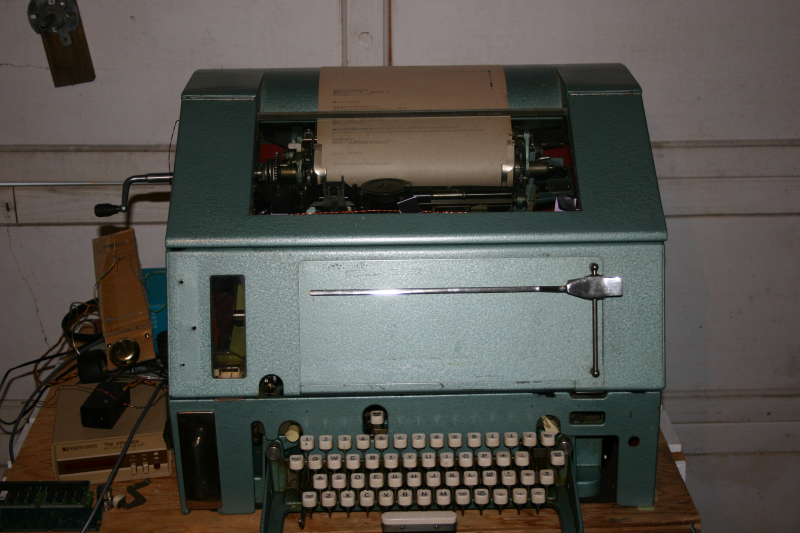What a dreamy, complicated, noisy, slow, clumsy, and downright fascinating piece of engineering history! Teletype machines in general were once extremely popular as a means to automate the transmission of text between two operators, between an operator and an unlimited number of receivers, to news stations, over the radio, over the telephone, direct-connected, etc. These machines were sometimes outfitted with paper tape readers, punches, or both in order to allow the storage and later retrieval of information.
Various encoding schemes were available over the years; my particular machine, the Model 15, uses the ITA.2 encoding scheme which is informally known as “Baudot” after Jean-Maurice-Émile Baudot, the French telegraph engineer responsible for the Baudot 5-bit encoding system for written text including basic control characters. While ITA.2 is not truly baudot, but a modification of it, it is loosely referred to as such.
The basic idea with ITA.2 coding, much like ASCII, EBCDIC, and others, is to create a standardized means of encoding human readable text using a fixed series of symbols for each letter, number, punctuation mark, etc. In this case, I use the term symbol to refer to the logical elements of an encoded word used in transmission or storage of the data. ITA.2 (and baudot) use a 5-bit word. This means that five symbols occur within each word and thus allow a maximum of 32 unique words to be encoded given that a symbol has two states (1 or 0, on or off, as binary encoding goes). The words may be transmitted in parallel format, such as rows of five hole positions on punch tape, or in serial format, such as when transmitted via a telegraph line. The reason for this serial transmission is mainly to allow use of classical telegraph lines and relay equipment which would only allow a single circuit, thus no “parallel” operation which would otherwise require one line for each bit or symbol in the word.
One might correctly guess that 32 unique words isn’t enough to contain the alphabet, the numbers, the punctuation marks, and any other things you might want to send (like control words that tell the machine to advance the paper, return the carriage, ring the bell, ask who’s there, start the motor, etc. (all of which the machine indeed does!)). The solution to the limitation is that there are two extremely special words known as “shift” and “unshift”; each literally shifting the entire print mechanism of the teletype machine between two sets of typefaces. This allows a doubling of the printable characters, while still leaving room for a few control words and so on.
So in a nutshell, this machine accepts a typed character, generates an internal parallel five bit word, and shifts it out onto a telegraph line in serial. The exact inverse occurs when receiving data; a serial word arrives on the telegraph line, the machine shifts it into a parallel five bit register which selects either a character to be printed, or a special machine function, and then the machine prints or performs the according function. In the intermediate step of both transmitting and receiving (the moment where a parallel five bit word exists in the machine) the data can be recorded to, or read from, the punch tape rather than sent/received via the telegraph circuit.
All the explanation aside, it is fascinating to look at. I will be doing a minor overhaul on this unit, setting it up, and doing some videos soon enough, so they should get added here when that happens!
Some nice pictures.

